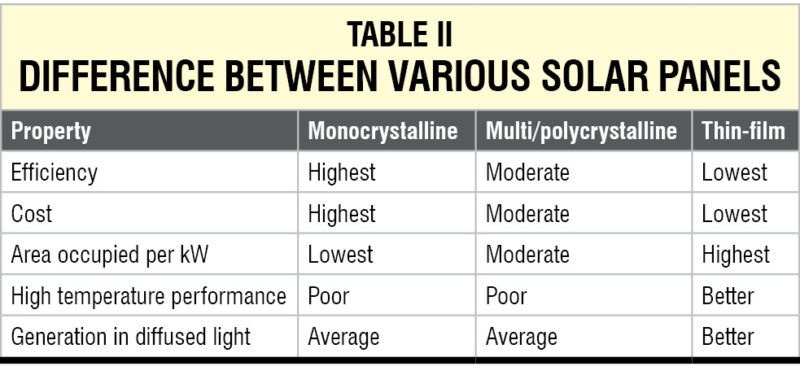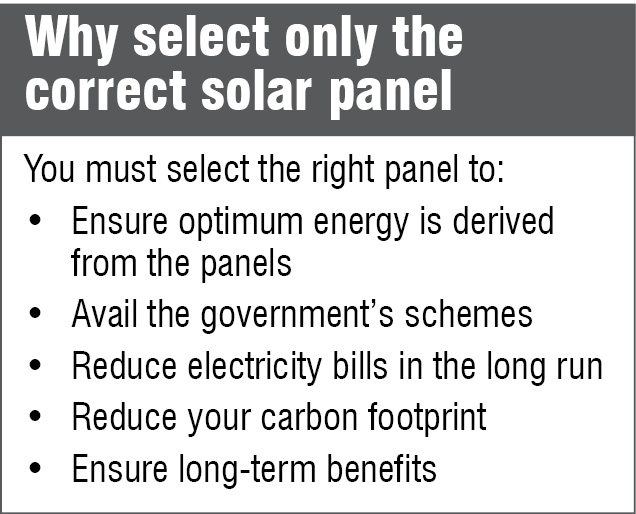India is blessed with abundant sunshine for most of the year. Switching to solar energy is therefore an extremely logical option. Solar energy is more economical and environment-friendly as compared to non-renewable sources of energy like coal and petroleum. The government of India has launched training programmes, framed solar net-metering guidelines as well as announced other incentives to promote the use of solar energy. Selecting the right product is critical for the smooth running of daily operations. This guide will assist you in making an informed decision on selecting appropriate rooftop solar panels for your home or office.
What solar panels are
Solar panels (also called photovoltaics) are primarily rectangular silicon devices that can convert light into electricity. These comprise several solar cells, which are spread over a large area that can work together to offer sufficient power for it to be deemed useful. Efficacy of solar panels depends on how well these face the sun.
Solar cells are available in all sizes, colours and power ratings. Applications that require minimal amount of power (20W to 40W) include solar lamps, lanterns, torches and so on. Rooftop installations require panels with heavier output of 150W to 300W or even more.
These are of the following two types:
Crystalline-silicon panels. These include monocrystalline and multi-crystalline panels. The former produce higher amount of power and are costlier than the latter.
Thin-film panels. These are used in building integrated photovoltaic applications, where these become a part of the building structure.

Factors that determine price
Price of a solar panel can vary from ₹ 30/kW to ₹ 60/kW. An imported module can cost about ₹ 40/kW to ₹ 45/kW. Good ones manufactured in India can cost ₹ 30/kW to ₹ 32/kW (for bulk transactions). Retail price of a module producing 3W – 40W may vary between ₹ 60/kW and ₹ 90/kW and modules producing 50W – 300W between ₹ 55/kW and ₹ 60/kW.
Price of solar panels varies according to type, wattage, brand and testing standards, as explained below.
Type. Thin-film panels cost less than crystalline silicon panels.
Wattage. Panels that have a higher power output have a higher price as these produce more electricity.
Brand. Good brands command a higher price, while cheap, imported Chinese panels cost less.
Testing standards. Panels that conform to government approvals and testing standards meet a minimum amount of performance and safety conditions; hence, are costlier.

Key pointers for selecting the right solar panel
 Heat tolerance and temperature co-efficient of solar panels. This means that if a panel is rated as 100W, it should generate 100W under standard test conditions. In case the maker says that the panels have a tolerance of ±5 per cent, it implies that the same panel can give either 105W or even 95W. Hence, you must ensure that your solar panel has a positive tolerance mentioned on the datasheet.
Heat tolerance and temperature co-efficient of solar panels. This means that if a panel is rated as 100W, it should generate 100W under standard test conditions. In case the maker says that the panels have a tolerance of ±5 per cent, it implies that the same panel can give either 105W or even 95W. Hence, you must ensure that your solar panel has a positive tolerance mentioned on the datasheet.
Temperature. Generally, panels are rated as per standard test conditions, that is, 25°C. If temperature is higher than this, panels may give less than the rated output.
Government and third-party certifications. These are as follows:
1. Panel-type certifications
2. Crystalline silicon terrestrial PV modules: IEC 61215/ IS 14286
3. Thin-film terrestrial PV modules: IEC 61646
Also, panels must conform to IEC 61730 part I requirements for construction and part II requirements for testing and safety qualifications.
Warranty and guarantee. Indian manufacturers give one to five years warranty. Some also give linear performance guarantee, which is even better. A good panel should last as much as 25 years and perform faultlessly for at least ten years.
Installation costs. Although cost of a solar panel constitutes 70 per cent of the total cost of the solar power system, there is also an additional installation cost that must be kept in mind before doing a budget calculation. More the power required by your operations, more will be the number of panels to be installed. This will lead to higher cost.
Location and condition of the panel. Ensure that the panel is facing sunlight as even a single partially-shaded panel adversely impacts the output of all solar panels in the system. Keep the panels free of dust to avoid shading. The panels should be kept at an angle. It will help in harvesting optimum energy from the sun.
Voltage. Most solar panels are designed to provide 16V, which can be used to charge a 12V battery.
Robust design. It must be made of tough material to withstand extreme climatic conditions.
Financial assistance. To comply with the government’s net-metering guidelines, each household should ideally install solar panels capable of generating at least 1kW of solar energy.
Do you like this article? You may also like these related articles: click here
Ruchira Prasad was working as a senior correspondent at EFY until recently







Most helping…
Thank you for your feedback.